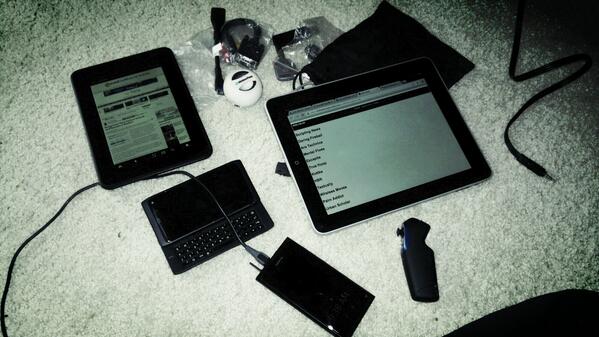At the recent ICCM USA Conference, one of the presentations done was about sharing content from your mobile device to others. One of the reasons for doing this presentation was that there are many in the missions space who get on the field, and then cannot use the familiar methods of email, Dropbox, etc. to share content between team members or even to others. Other methods have to be explored, and it was in this session that we took a glance at those mobile-centric ways of sharing. Following the demo/deck is one way to see what was going on, but we want to address a question from Twitter that asked how we actually did the demo/presentation, and how that follows along with this concept of being able to share content from your mobile device. Here are the elements used to make and execute the demo/deck:
- Nokia N9 smartphone
- N9 software: Personal Web Server, MeeTxtEdit
- iPad and Kindle Fire HD (w/HTML editing software on both, Textastic and DroidEdit Pro)
- Shared WiFi at the conference area
Essentially, I just made a webpage that others in the presentation would be able to look at. The page used HTML5 and jQuery features for making the page usable when my server was turned off and for transitions. That’s the simple explanation, here’s the more detailed way it happened:
I wanted to make a slide deck that both led the participant into the topic of understanding how content can be shared from a mobile device while also being a living demonstration of what that can look like. However, in making the decision that it had to be a living demo, it had to be a demo that was far enough “out there” that the simpler methods of sharing content from one’s mobile were more acceptable.
I settled on a simple outline that iterated the story of sharing content on a mobile. I wanted to focus a bit more on the history of sharing and what makes sense to share in specific contexts. The outline was done in a combination of a personal TiddlyWiki website and Evernote.
After setting the outline in HTML – specific to use HTML 5 for this, I then looked to enable the path one would go through the slides using jQuery-enabled buttons…
The next step was to utilize the specific feature, AppCache, in order to allow for the presentation to be usable when access to my mobile server was no longer available. I do admit that I’m banking on the unsafe tendency of persons to not clean the browser cache so that this would be available well after the fact.
Finally, it was simply making any final edits (using MeeTxtEdit) and then launching the mobile sever. I went the low-tech route of just writing the IP address of my mobile and the username and password on the whiteboard behind me. From there, it was just a matter of making sure that everyone could log in.
Lessons Learned
- For some reason, a person using a Windows Phone device (the Nokia Lumia 920) was not able to access the site. That’s something for me to look into
- Making sure that the site worked was not difficult, though I did have to pay attention to the room we were in and if there were more than one access point folks could come through. In another application of this, I ran a mobile hotspot from my phone, then let the server IP address get assigned from that. Its a bigger hit on the battery that way, but more controlled.
- Leveraging the internet-abilities of the devices present was key for some of the assets; but I made sure that all needed assets (images, jQuery file, etc) were downloaded from my device, not from the Internet
- Trying this with an Android device would work, possibly with an older BlackBerry device, and definitely a Nokia Symbian device; but you’d need to jailbreak an iPhone (or iPod Touch), and you can almost forget trying this using a feature phone (Nokia’s Asha series, etc.).
As I point to in the demo/deck, its actually possible to share content from your mobile using several methods. The thing with mobile to mobile sharing is that you will have to interact with people to figure out what works best, if you don’t already know the social norms. Once you’ve gotten that figured out, making something like this would work without fail.
Take a look again at the demo/deck from the ICCM USA Conference, and feel free to ask questions and offer feedback.
